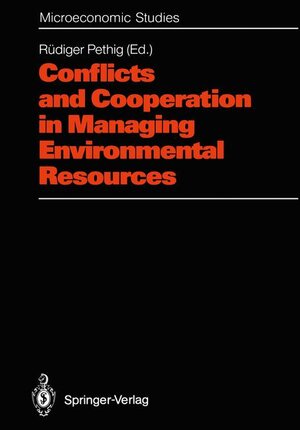
×
![Buchcover ISBN 9783540549680]()
Conflicts and Cooperation in Managing Environmental Resources
herausgegeben von Rüdiger PethigInhaltsverzeichnis
- Editor’s Introduction.
- 1: International Dimensions.
- 1 International Environmental Agreements as Games.
- 1. Introduction.
- 2. Reaching agreement.
- 2.1. Identical countries.
- 2.2. Cost differences.
- 2.3. Benefit differences.
- 2.4. Choice of a benchmark.
- 2.5. Summary.
- 3. Sustaining agreement.
- References.
- Comments by Henk Folmer.
- 2 Emission Taxes in a Dynamic International Game of CO2 Emissions.
- 2. A static game.
- 3. A dynamic game.
- 4. The open loop equilibrium without taxes.
- 5. The Markov perfect equilibrium without taxes.
- 6. Other subgame perfect equilibria.
- 7. Pigouvian taxes.
- 8. Non-commitment and taxation.
- Comments by Otto Keck.
- 3 Critical Loads and International Environmental Cooperation.
- 1. Critical loads.
- 2. Naive interpretations.
- 3. Stock of pollutants — the case of one country.
- 4. Stock of pollutants — several countries and the open loop equilibrium.
- 5. Closed loop or feed back equilibria.
- Comments by Henry Tulkens.
- 4 Environmental Conflicts and Strategic Commitment.
- 2. Analytical framework.
- 3. Asymmetric players and endogenous strategic timing.
- 4. N players and strategic team formation.
- 5. Conclusion.
- Comments by Detlev Homann.
- 5 The Choice of Environmental Policy Instruments and Strategic International Trade.
- 2. The model.
- 3. Single stage Cournot model.
- 4. Two stage Stackelberg model.
- 5. Two stage Cournot model.
- 6. Conclusions.
- Comments by Marji Lines.
- 6 Economic Models of Optimal Energy Use under Global Environmental Constraints.
- 1: The CO2 Problem in Basic Models of Optimal Use of Fossil Fuels.
- 2. Background problem on climatic change and global environmental constraints.
- 3. Economic studies on the CO2 problem.
- 4. Preliminary definitions and the general model.
- 5. A simplified model.
- 5.1. Necessary conditions.
- 5.2. Sufficient conditions.
- 5.3. Definition and optimality of equilibrium.
- 5.4. Illustration by a phase plane diagram.
- 6. A discrete type impact of CO2 emissions.
- 7. Further specification of the model.
- 8. Discussion.
- 2: Technical Change, International Co-operation, and Structural Uncertainty.
- 10. A taxonomy of technical change.
- 11. Neutral technical change in a general model.
- 12. International co-operation.
- 13. Structural uncertainty.
- 13.1. Modelling uncertainty about critical CO2 levels as uncertainty about a critical, limited natural resource.
- 13.2. Treating structural uncertainty.
- 13.3. Numerical calculations.
- 14. Conclusions and perspectives.
- Appendix A: Existence and Uniqueness of the Optimal Solution.
- Appendix B: Existence and Stability of Equilibrium.
- Comments by Oskar Von Dem Hagen.
- Comments by Cees Withagen.
- 2: Monitoring and Enforcement.
- 7 Monitoring and Enforcement of Pollution Control Laws in Europe and the United States.
- 2. Differences among monitoring and enforcement problems and systems.
- 3. Key dimensions of monitoring and enforcement systems.
- 3.1. Probability of monitoring.
- 3.2. Surprise.
- 3.3. Definition of a violation.
- 3.4. Penalties and other responses to violations.
- 4. Some evidence on European & U. S. choices in monitoring & enforcement.
- 5. A glimpse of the future? Recommendations from the U. K. (The “Kinnersley Report”).
- 6. Concluding comments.
- Comments by Heinz Welsch.
- 8 The Economics of Negotiations on Water Quality — An Application of Principal Agent Theory.
- 2. The basic model structure of a modified LEN-model.
- 3. The basic model with a beta—distribution of water quality depending on abatement intensity.
- 4. Possible extensions.
- Comments by Günther knieps.
- 9 Monitoring the Emission of Pollutants by Means of the Inspector Leadership Method.
- 1. Monitoring point sources of pollution.
- 2. Decision theoretical formulation of the problem.
- 3. Comparison of the solutions of the simple’ simultaneous’ and ‘leadership’ games.
- 4. The general inspector leadership game and the Neyman —Pearson lemma.
- 5. Application.
- 6. Concluding remarks.
- Comments by Till Requate.
- 10 Illegal Pollution and Monitoring of Unknown Quality — A Signaling Game Approach —.
- 1: Equilibrium Scenarios with Pooling and Signaling Behavior.
- 2. The game model.
- 3. A gallery of equilibrium scenarios.
- 3.1. Pooled shirking and illegal waste disposal: ‘polluter’s paradise scenario’.
- 3.2. Exploratory accidents and illegal waste disposal due to unqualified control: ‘signaling scenarios’.
- 3.3. Absence of illegal pollution due to efficient control: ‘controller’s paradise scenario’.
- 3.4. Intermediate illegal pollution: ‘constrained polluter’s paradise scenario’.
- 3.5. Equilibrium scenarios and the multiplicity of equilibria.
- 2: Perfect Equilibria and (Unique) Solutions via Equilibrium Selection.
- 4. Uniformly perfect pure strategy equilibria.
- 5. Comparison of signaling and pooling equilibria.
- 5.1. Cell and truncation consistency.
- 5.2. Payoff dominance.
- 5.3. Risk dominance.
- 5.4. Solutions in the range (4.14).
- 5.5. The solution in the range (4.15).
- 5.6. Discussion of the solution.
- Comments by Aart de Zeeuw.




